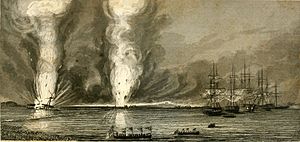
The First Opium War, also known as the Anglo-Chinese War, was a series of military engagements fought between the British Empire and the Qing dynasty of China between 1839 and 1842. The immediate issue was the Chinese enforcement of their ban on the opium trade by seizing private opium stocks from mainly British merchants at Guangzhou and threatening to impose the death penalty for future offenders. Despite the opium ban, the British government supported the merchants' demand for compensation for seized goods, and insisted on the principles of free trade and equal diplomatic recognition with China. Opium was Britain's single most profitable commodity trade of the 19th century. After months of tensions between the two states, the Royal Navy launched an expedition in June 1840, which ultimately defeated the Chinese using technologically superior ships and weapons by August 1842. The British then imposed the Treaty of Nanking, which forced China to increase foreign trade, give compensation, and cede Hong Kong Island to the British. Consequently, the opium trade continued in China. Twentieth-century nationalists considered 1839 the start of a century of humiliation, and many historians consider it the beginning of modern Chinese history.
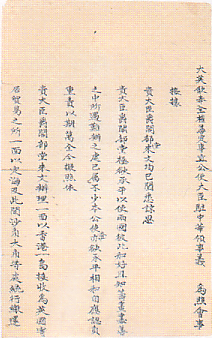
The Convention of Chuenpi was a tentative agreement between British Plenipotentiary Charles Elliot and Chinese Imperial Commissioner Qishan during the First Opium War between the United Kingdom and the Qing dynasty of China. The terms were published on 20 January 1841, but both governments rejected them and dismissed Elliot and Qishan, respectively, from their positions. Foreign Secretary Lord Palmerston stated that Elliot acquired too little while the Daoguang Emperor believed Qishan conceded too much. Palmerston appointed Major-General Henry Pottinger to replace Elliot, while the emperor appointed Yang Fang to replace Qishan, along with Yishan as General-in-Chief of Repressing Rebellion and Longwen as an assistant regional commander. Although the convention was unratified, many of the terms were later included in the Treaty of Nanking (1842).
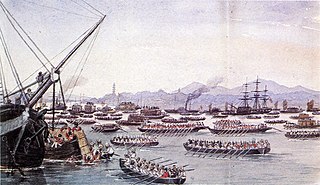
The Second Battle of Canton was fought between British and Chinese forces in Canton (Guangzhou), Guangdong province, China, in May 1841 during the First Opium War.
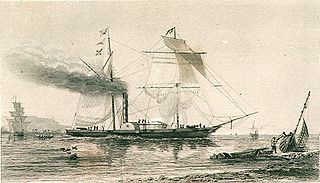
Nemesis was the first British ocean-going iron warship. She was the largest of a class of six similar vessels ordered by the 'Secret Committee' of the East India Company. Nemesis, together with her sister ships Phlegethon, Pluto, Proserpine, Ariadne, and Medusa, was built by John Laird's yard at Birkenhead and William Fairbairn & Sons at Millwall.
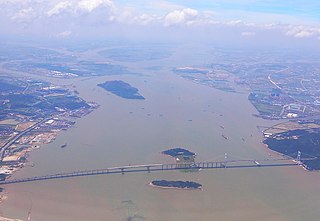
The Humen, also known as the Bocca Tigris or the Bogue, is a narrow strait in the Pearl River Delta that separates Shiziyang in the north and Lingdingyang in the south. It is located near Humen Town in China's Guangdong Province. It is the site of the Pearl River's discharge into the South China Sea. It contains the Port of Humen at Humen Town. The strait is formed by the islands of Chuenpi and Anunghoy on the eastern side, and Taikoktow on the western side. Since 1997, the strait has been traversed by the Humen Pearl River Bridge. Bocca Tigris was the entry to China's only trading city, Canton.

The Second Battle of Chuenpi was fought between British and Chinese forces in the Pearl River Delta, Guangdong province, China, on 7 January 1841 during the First Opium War. The British launched an amphibious attack at the Humen strait (Bogue), capturing the forts on the islands of Chuenpi and Taikoktow. Subsequent negotiations between British Plenipotentiary Charles Elliot and Chinese Imperial Commissioner Qishan resulted in the Convention of Chuenpi on 20 January. As one of the terms of the agreement, Elliot announced the cession of Hong Kong Island to the British Empire, after which the British took formal possession of the island on 26 January.

The Battle of the Bogue was fought between British and Chinese forces in the Pearl River Delta, Guangdong province, China, on 23–26 February 1841 during the First Opium War. The British launched an amphibious attack at the Humen strait (Bogue), capturing the forts on the islands of Anunghoy and North Wangtong. This allowed the fleet to proceed further up the Pearl River towards the city of Canton (Guangzhou), which they captured the following month.

The Battle of the Barrier was fought between British and Chinese forces at the boundary separating Macao from the Chinese mainland on 19 August 1840 during the First Opium War. Located in modern-day Portas do Cerco, the Macao Peninsula was connected to Xiangshan Island by a narrow isthmus about 100 m (330 ft) wide and 1.2 km (0.75 mi) long. A wall called the Barrier was built across the isthmus in 1573, and it served as Macao's border.

The First Capture of Chusan by British forces in China occurred on 5–6 July 1840 during the First Opium War. The British captured Chusan (Zhoushan), the largest island of an archipelago of that name.

The Battle of Whampoa was fought between British and Chinese forces at Whampoa Island on the Pearl River near the city of Canton (Guangzhou), Guangdong, China, on 2 March 1841 during the First Opium War.

Vice-Admiral Sir Thomas Herbert, KCB, was a British Royal Navy officer. He served in the Napoleonic Wars, War of 1812, and First Anglo-Chinese War. From 1847 to 1849, he was commodore of the South East Coast of America Station. Herbert served as Member of Parliament for Dartmouth as a Conservative from 1852 to 1857.

The Battle of Amoy was fought between British and Qing forces at Amoy on Xiamen Island, Fujian, in the Qing Empire on 26 August 1841 during the First Opium War. The British captured the forts at Xiamen and on nearby Gulangyu Island.

The Battle of Chinkiang was fought between British and Chinese forces in Zhenjiang (Chinkiang), Jiangsu province, China, on 21 July 1842 during the First Opium War. It was the last major battle of the war. The Chinese force consisted of a garrison of Manchu and Mongol Bannermen. In command of the British forces was Sir Hugh Gough. Leading one brigade was future British field marshal Sir Colin Campbell. The British capture of this stronghold allowed them to proceed to Nanjing. Fought near the confluence of the Grand Canal and Yangtze River, the battle effectively blocked operation of the Caoyun system, a transport network vital for the movement of grain throughout the empire. As a result, the Daoguang Emperor decided to sue for peace and agreed to sign the Treaty of Nanking, which brought hostilities to an end. Mass suicide was committed by the Manchu Bannermen who were defending the city.

Guan Tianpei, courtesy name Zhongyin (仲因), art name Zipu (滋圃), was a Chinese admiral of the Qing dynasty who served in the First Opium War. His Chinese title was "Commander-in-Chief of Naval Forces". In 1838, he established courteous relations with British Rear-Admiral Frederick Maitland. Guan fought in the First Battle of Chuenpi (1839), the Second Battle of Chuenpi (1841), and the Battle of the Bogue (1841). The British account described his death in the Anunghoy forts during the Battle of the Bogue on 26 February 1841 as follows:
Among these [Chinese officers], the most distinguished and lamented was poor old Admiral Kwan, whose death excited much sympathy throughout the force; he fell by a bayonet wound in his breast, as he was meeting his enemy at the gate of Anunghoy, yielding up his brave spirit willingly to a soldier's death, when his life could only be preserved with the certainty of degradation. He was altogether a fine specimen of a gallant soldier, unwilling to yield when summoned to surrender because to yield would imply treason.
Admiral Sir Henry Smith was a British officer in the Royal Navy. He commanded the Aden Expedition in 1839 which took Aden as the first colonial acquisition of the reign of Queen Victoria. For this service he was appointed a Companion of the Order of the Bath. Smith was then sent to serve on the China Station, where he fired the first shot of the First Opium War at the Battle of Kowloon. He played an important role at the controversial Battle of Chuenpi later in the year, and as senior naval officer on the south coast of China fought the Battle of the Barrier. He later participated in the Battles of Second Chuenpi, the Bogue, and Canton, before forming part of the Amoy garrison after the Battle of Amoy. Having left China in 1843, he went on to command ships in the Mediterranean and then in the Baltic Sea during the Crimean War. Smith never served at sea again after obtaining flag rank in 1855 but became superintendent of the Royal Hospital Haslar and the Royal Clarence Yard. He was appointed a Knight Commander of the Order of the Bath in 1873, retiring in the same year.

The Broadway expedition was a British military expedition that explored the Broadway River in Guangdong province, China, on 13–15 March 1841 during the First Opium War. The river was also called the Inner Passage or Macao Passage as it served as an intricate channel from the Portuguese colony of Macao to the Chinese city of Canton (Guangzhou). The expedition was the first time a European vessel traversed the passage, and was believed by the Chinese to be inaccessible to foreigners due to the shallowness and intricacy of the channel as well as the forts along the banks. The iron steamship Nemesis had a shallow draught of 6 feet (1.8 m), which was a major advantage in navigating the river. Despite being over 600 tons burden, the ship was able to navigate through a river that frequently had less than 6 feet of water and through mud in areas of only 5 feet (1.5 m).

The First Battle of Canton was fought between British and Chinese forces in Canton, Guangdong Province, China, on 18 March 1841 during the First Opium War. The capture led to the hoisting of the Union Jack on the British factory in Canton and the resumption of trade between the British and the Chinese.
Yang Fang (1770–1846) was a Han Chinese general and diplomat during the Qing dynasty (1644–1911). Born in Songtao, Guizhou Province, he joined the military as a young man and became a secretary, where he came to the attention of General Yang Yuchun, who recommended him for military school.

Porcher was launched in 1799 at Calcutta. She made one voyage for the British East India Company (EIC) from Bengal to England. A French privateer captured her in 1802, which gave rise to a case in French courts about the validity of the capture given the impending Treaty of Amiens. The French courts condemned her in prize and new owners in Bordeaux named her Ville de Bordeaux. The British recaptured her in 1804. Thereafter she traded between England and India as a licensed ship. In 1809 she sailed to England where in 1810 new owners renamed her Cambridge. As Cambridge she made three voyages for the EIC as an extra ship. In 1818 she was again sold with her new owners continuing to sail her to the Far East as a licensed ship. She then made two more voyages to India for the EIC. In 1840 she was sold to an American trading house at Canton, and then to the Qing Dynasty, which purchased her for the Imperial Chinese Navy. The British Royal Navy destroyed her on 27 February 1841 during the Battle of First Bar at the onset of the First Opium War.
Events from the year 1841 in China.
